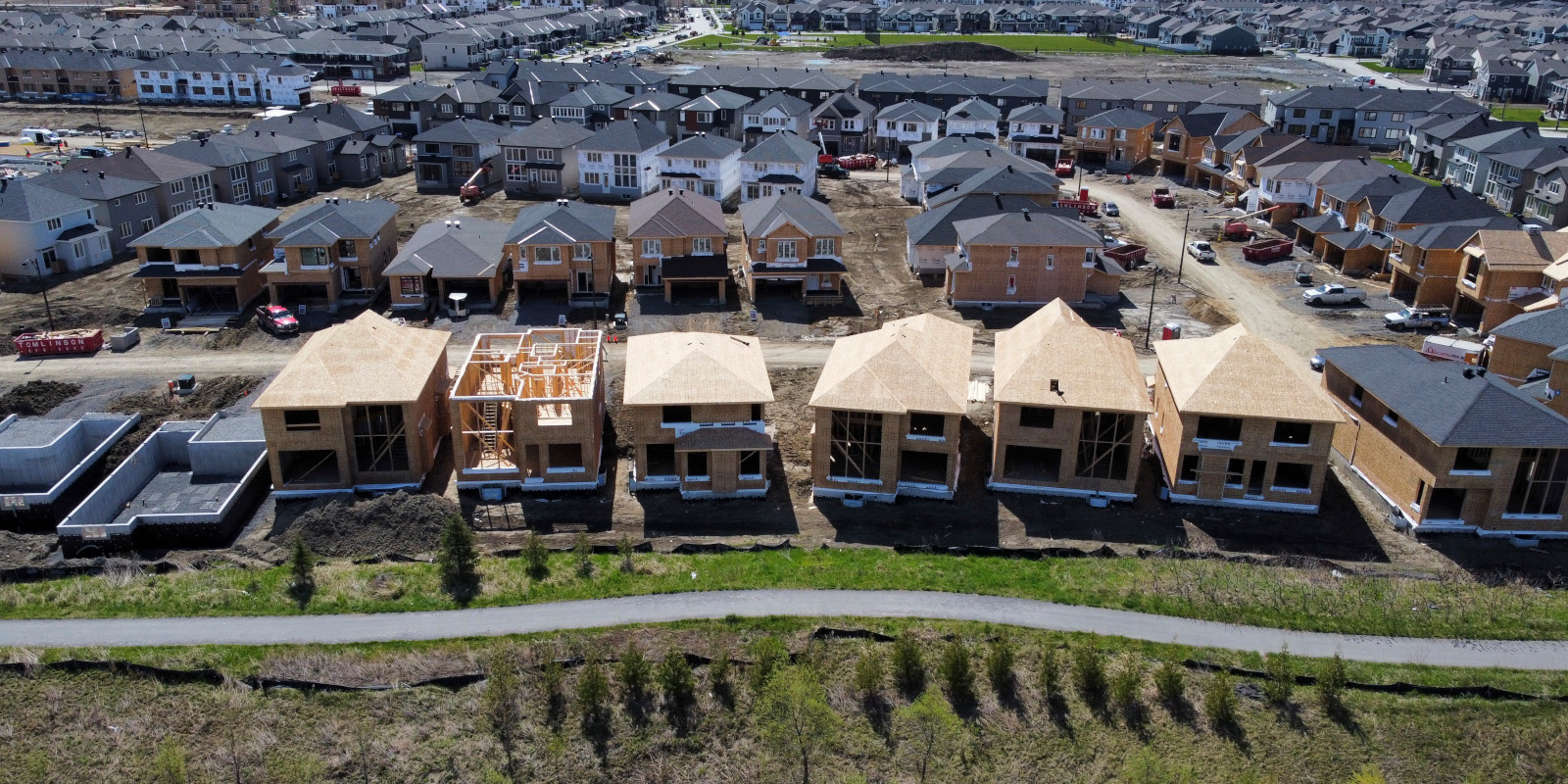At A Glance
- A study by the Canadian Mortgage and Housing Corporation estimates B.C. needs to build 570,000 homes by 2030 to restore housing affordability.
- Ontario’s plan to build 1.5 million new homes by 2031 is ambitious. “We’ve never had that level of construction. Could we do it? Possibly,” says Tony Stillo of Oxford Economics.
- B.C. New Democrats are promising to harness the power of government-led development to bring down costs. “I wonder how that scales, when you’re talking about the overall massive supply shortage,” says Owen Brady of Abundant Housing Vancouver.
Ontario’s Doug Ford and the newly-inaugurated David Eby in British Columbia are two premiers with big plans to tackle housing affordability in their provinces, but can they deliver on their ambitious promises to meaningfully change the housing market?
Housing advocates in B.C. and Ontario are united in praising Eby’s plan and Ford’s More Homes Built Faster Act as important steps toward affordability in an environment where tight supply and high demand are often blamed for pushing housing costs through the roof.
The two plans have key differences, with Ford, the Progressive Conservative, touting the power of a deregulated and unleashed private sector-led approach, while David Eby and the New Democrats are promising to harness the power of government-led development to bring down costs.
These same housing advocates also echo one another in saying neither plan goes far enough, and both miss or overlook important aspects of stabilizing the housing dynamics in the two provinces.

Owen Brady is a director with Abundant Housing Vancouver, a pro-housing advocacy group. On a scale of one to 10, he gives Eby’s plan a seven, praising its breadth, including a toughened government stance on property flippers and pushing B.C. municipalities to upzone parcels of land within their boundaries.
Among Eby’s other promises are softening some restrictions on rentals, and a pledge to approve housing projects on public land with the aim of expanding government-led housing development in the province.
Furthermore, Eby is promising $500 million for nonprofits to “jumpstart” their acquisition of affordable rental housing buildings. This is aimed at countering “huge international corporations” that buy up rental housing with the intention to raise rents and in turn squeeze out middle-income residents, seniors, and other vulnerable persons.
“It’s probably one of the more promising things we’ve seen come around, and compared to other jurisdictions, I think it has potential,” says Brady regarding Eby’s plan for B.C.
Unlike Ford’s More Homes Built Faster Act, which passed through first reading at the Ontario legislature in October, Eby’s plan was a promise from his successful NDP leadership campaign and contains fewer details at this point.
From Brady’s perspective, Eby’s plan is not without flaws, including that it does not have enough clearly defined goals regarding housing supply.
A study by the Canadian Mortgage and Housing Corporation estimates B.C. needs to build 570,000 homes by 2030 to return to affordability.
“They want to build a lot of non-market housing with controls to keep it affordable, so that they’re not just giving away that public benefit…and a real focus on pulling out all the stops to build more of it, so that’s good,” says Brady. “I wonder how that scales, when you’re talking about the overall massive supply shortage…the housing needs assessments are not very comprehensive.”
Another solution proposed by Eby that Brady says is imperfect is the pledge to allow three units to be built on single-family properties in B.C., including the primary house, a laneway house, and a basement suite. This was already formally legalized by the City of Vancouver in 2008.
“That helps in some places. It doesn’t really do much in Vancouver,” says Brady.
Eby’s plan does briefly mention intentions to upzone parcels of land in municipalities to densify them, but there are no specific numbers of units planned for construction.
Vancouver’s West End neighbourhood in the downtown core has the densest concentration of housing in the city, with dozens of multistory rental properties, and is one of the city’s more affordable areas to rent.
“No doubt that if you have a large supply of rental units, you end up having more affordable housing for renters,” says Tony Stillo, director of economics for Canada at Oxford Economics. “Is it a coincidence? No, I think there’s a relationship there.”
Rocky Petkov is an organizer with More Neighbours Toronto, which shares the goals of Abundant Housing Vancouver but in Canada’s largest city.
While Petkov says Ford’s More Homes Built Faster Act is a start, he wishes it focused on more density in Ontario’s larger cities like Toronto, Hamilton, and Ottawa instead of emphasizing aspects like allowing three units on formerly single-family properties.
“Maybe for King City, for Markham, three units is perhaps a good baseline. But for places like Toronto, is it really? No,” says Petkov.
Ford’s government has promised to drastically reduce many of the fees currently charged for developing smaller projects and speed up the process. Furthermore, many imposed costs like the municipal development charge will be lifted for non-profit housing.
Petkov says the More Homes Built Faster Act does not address the problems that may arise from conflicts with municipal building bylaws during densification. The Act explicitly states that developments on existing properties must be compliant with municipal bylaws and the building code.
“While the province is taking a really big step and something unprecedented (by) going toward three units, they’re not necessarily doing anything to change built form requirements, and by that I mean setbacks, height restrictions, maximum building size,” says Petkov. “Those things are just as important if we want to encourage the construction of missing middle density.”
Petkov is critical of the Ford government’s recent plans to increase Hamilton’s city limits to enable more sprawl when Hamilton’s municipal government had already voted to upzone land within its existing city limits.
“I think that you’ve got to have some densification of underutilized urban centres if people want to live in an urban centre. And we have the ability to put in multi-units in existing properties” says Tony Stillo. “I think any way that you can introduce a sustainable increase in housing supply, and be creative in that regard, I think that’s wonderful.”
Mandating the upzoning and densifying of residential areas near transit hubs is a prominent feature of the More Homes Built Faster Act, which Petkov praises as a step towards unlocking transit-oriented development in Ontario.
However, Petkov says minimum density targets set for Ontario municipalities by the provincial government need to be guaranteed.
“Those targets that they’re giving each city, those need to be binding, those need to have some sort of enforcement mechanism, they have to mean something,” says Petkov.
Regarding the Ontario government’s plan to build 1.5 million new homes by 2031, Stillo says it is a highly ambitious goal.
“It would be an unprecedented annual pace of housing starts of about 150,000 per year, and I think that’s going to be a challenge and a difficult one,” says Stillo. “We’ve never had that level of construction. Could we do it? Possibly.”
Petkov says the current economic and fiscal climate will pose challenges as rising interest rates make the cost of borrowing to build and develop far more expensive.
“I think it’s going to make certain projects that might have been viable with lower interest rates…potentially be put on the shelf,” says Petkov. “Your construction loan that you might have gotten (at) two percent, three percent, now it’s going to be quite a bit higher than what you would have gotten a year ago…and it’s really unfortunate it’s happening at this specific moment.”
British Columbia and Ontario are the two most popular destinations for immigrants to Canada. With the federal government wanting to attract 500,000 newcomers per year by 2025, the question of whether housing can keep up, or even catch up, will not become less urgent any time soon.
Recommended for You

Ginny Roth: J.D. Vance, Pierre Poilievre, and how they slice their economic pie

David Polansky: As President Biden leaves the race, will the Democratic Party hodgepodge hold?

Five Tweets on Western Canada’s devastating wildfires

Trevor Tombe: Canadians are paying billions in hidden taxes on new homes










